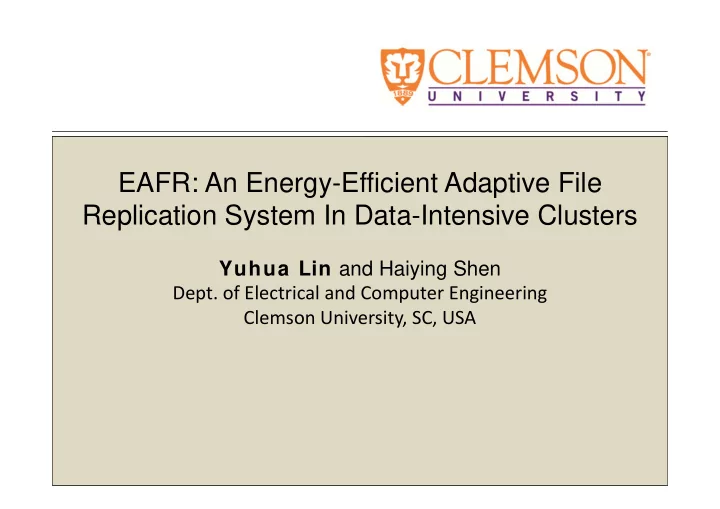

EAFR: An Energy-Efficient Adaptive File Replication System In Data-Intensive Clusters Yuhua Lin and Haiying Shen Dept. of Electrical and Computer Engineering Clemson University, SC, USA
Outline • Introduction • System Design • Motivation • Design of EAFR • Performance Evaluation • Conclusions 2
Introduction • File storage systems are important components for data-intensive clusters., e.g., HDFS, Oracle’s Lustre, PVFS.
Introduction Uniform replication policy: • Create a fixed number of replicas for each file • Store the replicas in randomly selected servers across different racks Advantages: • Avoid the hazard of single point of failure • Read files from nearby servers • Achieve good load balance
Introduction Uniform replication policy: • Create a fixed number of replicas for each file • Store the replicas in randomly selected servers across different racks Drawbacks: neglects the file and server heterogeneity • Cold files and hot files have equal number of replicas • Not energy-efficient • Random selection of replica destinations neglects server heterogeneity
Introduction Energy ‐ Efficient Adaptive File Replication System (EAFR) • Adapts to file popularities • Classifies servers into hot servers and cold servers with different energy consumption • Selects a server with the highest capacity as replica destination 6
Outline • Introduction • System Design • Motivation • Design of EAFR • Performance Evaluation • Conclusions 7
Motivation: Server Heterogeneity Energy consumption for different CPU utilizations [1] • Hot servers: run at the active state, i.e., with CPU utilization greater than 0 • Cold servers: sleeping state with 0 CPU utilization and do not serve file requests • Standby servers: temporary hot servers, collect all cold files and turn into cold servers when storages are full [1] A. Beloglazov and R. Buyya. Optimal online deterministic algorithms and adaptive heuristics for energy and performance efficient dynamic consolidation of virtual machines in cloud data centers. CCPE, 24(13):1397–1420, 2012. 8
Motivation: Files Heterogeneity Trace data: • File storage system trace from Sandia National Laboratories • Number of file reads for 16,566 files during 4 hour run • Observation 1: 43% files receive less than 30 reads, 4% files receive a large number of reads (i.e., > 400) 9
Motivation: Files Heterogeneity • Sort the files by the number of reads, identify the 99th, 50th, and 25th percentiles • Observation 2: files tend to attract a stable number of reads within a short period of time • Hint: group files into different categories based on popularity, perform different operations according to their popularities 10
Adaptive File Replication: Hot Files A hot file: 1. Average read rate per replica exceeds a pre ‐ defined threshold 2. More than a certain fraction (denoted by ) of a file’s replicas attract an excessive number of reads 11
Adaptive File Replication: Hot Files When to increase the # of replicas for a hot file? Sever capacity ( ): max # of concurrent file requests a server can handle : # of concurrent reads a server receives A server is overloaded if: An extra replica is needed when a large fraction of servers storing a hot file are overloaded. : a set of servers storing a hot file Where to place the new replica? Select a server with the highest remaining capacity 12
Adaptive File Replication: Cold Files A cold file: 1. Average read rate per replica bellows a pre ‐ defined threshold 2. More than a certain fraction (denoted by ) of a file’s replicas attract a small amount of reads 13
Adaptive File Replication: Cold Files When a file gets cold: 1. Maintaining at least replicas in hot servers to guarantee file availability 2. Move a replica from a hot server to a standby server 3. When a standby server’s storage capacity is used up, turn the standby server to a cold server 14
Outline • Introduction • System Design • Motivation • Design of EAFR • Performance Evaluation • Conclusions 15
Performance Evaluation: Settings Trace ‐ driven simulation platform: Clemson University’s Palmetto Cluster – 300 distributed servers – Storage capacities: randomly chosen from (250GB, 500GB, 750GB) – 50,000 files, randomly placed on the servers – Distributions of file reads and writes: follow CTH trace data [2] Comparison methods – HDFS: 3 replicas placed in random servers – CDRM: 2 replicas initially, increases replicas to maintain the required file availability 0.98 for server failure probability 0.1 [2] Sandia CTH trace data. http://www.cs.sandia.gov/Scalable IO/SNL Trace Data/ 16
Performance Evaluation: Results • File Read Response Latency Observation: HDFS>CDRM>EAFR • • Reason: EAFR adaptively increases the number of replicas for hot files, and the new replicas share the read workload of hot files. 17
Performance Evaluation: Results • Energy Efficiency Observation: EAFR manages to reduce the power consumption by more • than 150kWh per day • Reason: EAFR stores some replicas of cold files in cold servers (in sleeping mode), which results in substantial power saving 18
Performance Evaluation: Results • Load Balance Status Observation: EAFR achieves better load balance than CDRM and HDFS • • Reason: EAFR places new replicas in servers with the highest remaining capacity 19
Outline • Introduction • System Design • Motivation • Design of EAFR • Performance Evaluation • Conclusions 20
Conclusion • EAFR: energy ‐ efficient adaptive file replication system • Trace ‐ driven experiments from a real ‐ world large ‐ scale cluster show the effectiveness of EAFR: • Reduce file read latency • Save power consumption • Achieve better load balance • Future work: increasing data locality in replica placement 21
Thank you! Questions & Comments? Yuhua Lin yuhual@clemson.edu Electrical and Computer Engineering Clemson University 22
Recommend
More recommend